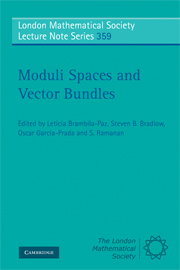Book contents
- Frontmatter
- Contents
- Preface
- Acknowledgments
- Part I Lecture Notes
- Part II Survey Articles
- 7 Moduli of Sheaves from Moduli of Kronecker Modules
- 8 Coherent Systems: a Brief Survey
- 9 Higgs Bundles Surface and Group Representations
- 10 Quotients by Non-Reductive Algebraic Group Actions
- 11 Dualities on T*SUX (2, OX)
- 12 Moduli Spaces for Principal Bundles
- Part III Research Articles
12 - Moduli Spaces for Principal Bundles
Published online by Cambridge University Press: 07 September 2011
- Frontmatter
- Contents
- Preface
- Acknowledgments
- Part I Lecture Notes
- Part II Survey Articles
- 7 Moduli of Sheaves from Moduli of Kronecker Modules
- 8 Coherent Systems: a Brief Survey
- 9 Higgs Bundles Surface and Group Representations
- 10 Quotients by Non-Reductive Algebraic Group Actions
- 11 Dualities on T*SUX (2, OX)
- 12 Moduli Spaces for Principal Bundles
- Part III Research Articles
Summary
Dedicated to Peter Newstead on occasion of his 65th birthday
Abstract
In this note, we will survey recent developments in the construction of moduli spaces of principal bundles with reductive structure group on algebraic varieties with special emphasis on smooth projective curves. An application of the theory of moduli spaces to the theory of moduli stacks will also be mentioned.
Introduction
Let k be an algebraically closed field, X a smooth, connected, and projective curve over k, and G a connected reductive linear algebraic group over k. This survey article is devoted to various aspects of the classification of principal G-bundles on X.
To begin with, let us look at the topological side. If k = ℂ, then any principal G-bundle may be viewed as a holomorphic principal G-bundle over X (viewed as a compact Riemann surface). As such, it defines a topological principal G-bundle on X. It is not hard to see that there is a bijection between the set of isomorphy classes of topological principal G-bundles on X and the fundamental group π1(G) ([Ram01], Proposition 5.1 see also Section 5.1). The fundamental group of G may be defined in terms of the root data of G. In particular, it is defined for reductive linear algebraic groups over any field k. Then, one can show that, over any field K, π1(G) parameterizes the algebraic equivalence classes of principal G-bundles on X ([DS], Proposition 5, [Holla], Proposition 3.15).
- Type
- Chapter
- Information
- Moduli Spaces and Vector Bundles , pp. 388 - 424Publisher: Cambridge University PressPrint publication year: 2009
- 2
- Cited by



